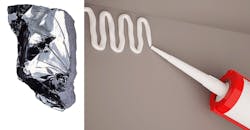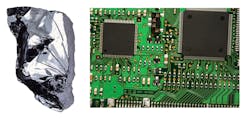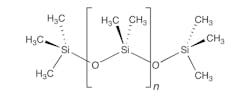What’s the Difference between Silicone and Silicon?
To make a long story short, silicon is an element and silicones are polymers containing silicon and oxygen, and often carbon and hydrogen as well.
Silicon: A Versatile Element Found in Nature and Technology
Silicon, the 14th element in the Periodic Table, is the seventh most common element in the universe and the second most common element on Earth (oxygen is the most common element). But this crystalline metaloid has a strong affinity for oxygen, so it is almost always found as silicon dioxide (aka silica and quartz). Silica can be found in a host of minerals, including flint, jasper, opal, and sandstone (and sand). It is also a key component in glass, concrete, and brick.
Raw silicon is a hard and brittle crystalline solid with a silver/grey-bluish luster. Once refined and purified, it serves as the basis for millions of semiconductors. (Courtesy: Thinkstock)
Silicates, which are a mix of silicon, oxygen, and reactive metals, include feldspar, granite, and mica. They are used in ceramics, enamels, Portland cement, mortar, stucco, and pottery.
Relatively pure silicon is most commonly used in refining steel, casting aluminum, and the chemical industry. But silicon is most widely noted for being the basis of many semiconductors, though less than 10% of the pure silicon goes to this purpose.
The principal component in silicone is polydimethylsiloxane, an inorganic polymer of silicon and oxygen. (Courtesy: Thinkstock)
Silicones: A Family of Synthetic Polymers with Unique Properties
Silicones, also known as polysiloxanes, are a family of man-made polymers that are usually liquid or a flexible, rubberlike plastic. The polymers have an inorganic chain of silicon and oxygen atoms with organic side groups attached to the silicon. They have several useful properties that make them the basis for a variety of consumer and industrial products including:
- Low thermal conductivity.
- Low electrical conductivity.
- Low toxicity.
- The ability to repel water and form watertight seals.
- They do not stick to most substrates, but does stick to glass.
- Physical properties remain the same despite changes in temperature.
- They resist oxygen, ozone, and ultraviolet light.
Silicones are used in sealants; adhesives; lubricants; medical products; both cosmetic and orthopedic implants; cooking utensils; tools; thermal and electrical insulation; coatings for paper, textiles, and gaskets; potting for electronics; and even as a dry-cleaning solvent.
Silicone has a variety of useful properties, letting it be used in watertight adhesives and nonstick cooking utensils. (Courtesy: Thinkstock)
How to Remember the Difference Between Silicon and Silicone
In sort of a bass-ackward mnemonic, you can keep the two straight by remembering that silicone, the polymer, has an e in it, which stands for element (which it isn’t). Conversely, the one without the e is an element.




